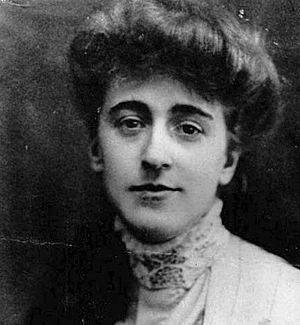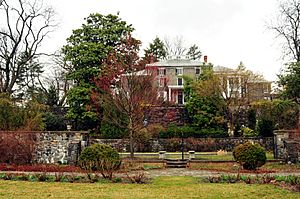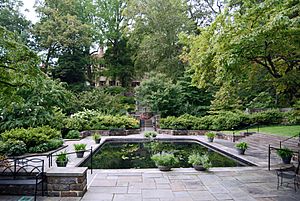Marian Cruger Coffin facts for kids
Quick facts for kids
Marian Cruger Coffin
|
|
|---|---|

Marian Cruger Coffin in 1904
|
|
| Born | September 16, 1876 Scarborough, New York, U.S.
|
| Died | February 2, 1957 (aged 80) New Haven, Connecticut, U.S.
|
| Education | Massachusetts Institute of Technology |
| Occupation | Landscape architect |
|
Notable work
|
Gibraltar, Winterthur, and Caumsett gardens |
Marian Cruger Coffin (born September 16, 1876 – died February 2, 1957) was an American landscape architect. She became famous for designing many beautiful gardens. These gardens were often for rich and powerful families on the East Coast.
When she was a child, Marian Coffin did not go to a regular school. She was taught at home by tutors. Even though it was hard for women to have professional careers back then, she decided to become an architect. She studied at the Massachusetts Institute of Technology (MIT) from 1901 to 1904. She was one of only a few women in her architecture and landscape design classes.
After finishing her studies, Marian Coffin found it hard to get a job. Many companies did not want to hire a woman in a field mostly for men. So, in 1905, she started her own business in New York City. She began by designing gardens for homes on Long Island. She was one of the first American women to work as a professional landscape architect.
As she became more well-known, she got bigger jobs from wealthy families. By the 1920s, she was one of the most popular landscape architects in the eastern United States. Her clients included very famous families like the Fricks, the Vanderbilts, and the du Ponts.
When the Great Depression started in 1930, she had fewer jobs. But she kept working almost until she died in 1957 at age 80. During her career, she worked on over 130 projects. Many of these were large estate gardens. Some of her most famous designs include the gardens at Gibraltar in Wilmington, Delaware, the campus of the University of Delaware, and the gardens at Winterthur.
Contents
Growing Up: Marian Coffin's Early Life
Marian Coffin was born into a wealthy family in Scarborough, New York. But her father, Julian Ravenel Coffin, died when she was seven. This meant her family lost most of their money. Marian and her mother, Alice, then lived with relatives in Geneva, New York.
She loved the beautiful nature around her in the Finger Lakes area. She once wrote that she loved "the great outdoor world." Even though they had little money, living with her mother's relatives gave Marian a good upbringing. She met many important people on the East Coast. These connections helped her a lot later in life.
Marian did not have much formal schooling. This caused some problems when she went to college. Instead, she was taught at home. She also learned about art and music and became a good horse rider.
As a young woman, Marian Coffin had to choose. She could either marry a rich man or start a career. She chose to work, even though it was unusual for women from her background. She wanted to do something creative. She later said she wanted to "create beauty" but didn't feel she had talent for painting or music. She realized she needed to earn a living.
Studying to Become a Landscape Architect
A friend who was an architect suggested she try "landscape gardening." This was the old name for landscape architecture. Beatrix Jones Farrand was a woman who had already become a pioneer in this field. Marian might also have been influenced by her uncle, Benjamin Church. He worked on Central Park in New York City with Frederick Law Olmsted.
At that time, women were starting to look for jobs beyond teaching or nursing. But few schools would let them study fields like architecture. The Massachusetts Institute of Technology (MIT) was one of the few that did. MIT started accepting women in 1870.
Marian applied to MIT but was first turned down. She didn't have enough formal schooling to meet the entry rules. But some teachers at MIT liked her and told her to keep trying. She studied math very hard. In 1901, she joined MIT as a special student. She was one of only four women in the architecture program. Only two of them were studying landscape architecture. These four women were the only female students among 500 men.
Marian Coffin took many architecture classes. She studied engineering, physics, math, and drawing. She also learned about plants and gardening from Charles Sprague Sargent. He taught at the Arnold Arboretum.
One of her most important teachers at MIT was Guy Lowell. He led the landscape design program. Lowell believed in classical design ideas like balance, order, and harmony. He was known for his book American Gardens. This book taught many landscape architects to design gardens that were symmetrical and combined buildings with classical garden decorations and plants. This style was like the famous Italian villas.
Another big influence was Charles A. Platt. He also believed that a house and its gardens should be designed together. He saw them as a series of indoor and outdoor "rooms." His 1894 book Italian Gardens greatly influenced Marian's designs. You can see parts of his style in her work, like the Gibraltar Gardens.
During her studies, she spent a summer in France and Italy. She visited famous gardens there. She also took trips to study estates in the Boston area. She was especially good at botany (the study of plants). She became friends with another student, Henry Francis du Pont. They later worked together to design the gardens at Winterthur, Delaware.
Marian described her college years as a "long grind" and "hard work." But she enjoyed her summer abroad. She and the other women in her program had a friendly competition with the male students. She said this made them work harder to prove they were serious students. She found working with many different types of men helpful. She said they had a good spirit in the drawing room, and she often got help when she needed it.
Starting Her Own Business
After graduating in 1904, Marian traveled in Europe with her mother. She visited famous gardens and met important people like Edith Wharton and Gertrude Jekyll. Jekyll, a British garden designer, greatly influenced Marian's later work.
When she came back to America, Marian found that most architecture firms would not hire a woman. She later wrote that people would ask, "My dear young lady, what will you do about supervising the work on the ground?" This meant they wondered how she would manage the workers. Because of this, she decided to open her own office.
She moved to New York City with her mother. They lived at the National Arts Club in Gramercy Park. Around 1905, Marian Coffin started her own business there. She used her family connections to find her first jobs. This was a good time for her to start. Wealthy Americans on the East Coast wanted to build fancy European-style gardens for their estates. Marian was well-connected, had traveled a lot, came from a good family, and was professionally trained. She also joined the American Society of Landscape Architects. At that time, only two other women were members.
Marian's first jobs were designing small flower gardens. For example, she designed a suburban garden for Edward Sprague in 1906 in Flushing, Queens. This garden was known for its original design. It was on a normal-sized lot, typical of new suburban areas on Long Island. Marian wrote about this garden in Country Life in America. She believed that even a regular homeowner could create a beautiful garden without spending too much money. She showed how even a plain lot could be made beautiful with good design.
As she became more famous, Marian Coffin got to use her design ideas on bigger projects. By 1911, her business was big enough that she needed an assistant. By 1918, she moved her office to a larger space. She also hired James Scheiner, an architect, to help her. He worked on big tasks like overseeing the work on the ground. This allowed Marian to take on even larger projects.
Marian insisted on being paid the same as male architects. This was new at a time when women usually earned less than men. She also liked to hire women to work with her. This gave them a chance to learn, which many women were denied when Marian first started her career.
Designing Famous Gardens
One of Marian Coffin's important jobs was designing a garden for William Marshall Bullitt's Oxmoor estate in Glenview, Kentucky in 1909. This job likely came from a recommendation by Henry du Pont. The Bullitt project led to two more similar jobs nearby in 1911. In 1910–11, she also designed gardens for Alfred Boardman in Southampton, New York.
In 1916, a relative of the du Ponts, Hugh Rodney Sharp, gave her a very famous job. This was to create the gardens of the Gibraltar estate in Wilmington, Delaware. She designed it in an Italianate Beaux-Arts style. It was like a series of "rooms" that matched the house. The garden had a strong geometric layout but was filled with many plants, like an informal English garden. It also had many decorative items like fountains, statues, and iron gates.
Marian Coffin tried to find work in the Midwest, but other landscape architects were already well-known there. Still, she had plenty of jobs. Her success was recognized when she was chosen as a Fellow of the American Society of Landscape Architects in 1918. By the 1920s, she was one of the most sought-after landscape architects on the East Coast.
Her work was shown in popular magazines and professional journals. Marian herself encouraged this as a way to market her work. She wanted to reach wealthy women who read magazines like the Garden Club of America's Bulletin. She hired top photographers to take pictures of her gardens. She also gave talks with slides. Her marketing worked very well and brought her many new jobs.
Most of her big projects happened between the end of the First World War and the start of the Great Depression. She took on several major projects. For example, she designed the landscape of the University of Delaware campus in 1919. She worked as the university's landscape architect from 1918 to 1952. Her job was to connect the university's two separate campuses. She did this by linking them with a circle, which made the different layouts look natural.
Other big projects included gardens for the Bayberryland estate on Long Island and the huge Caumsett estate (now Caumsett State Historic Park). In the late 1920s, two of her projects earned her the Gold Medal of Honor from the Architectural League of New York in 1930.
In 1926, Marian Coffin became very sick with a hip infection. She had to spend a long time in the hospital. She moved to a new house in New Haven, Connecticut. But she still kept her office in New York and traveled there every day. She often had guests at her New Haven home. She liked to spend time with young architects, artists, and writers.
Later Years and Legacy
Marian Coffin's designs were special. She used strong contrasts in color and included wildflowers. She also made sure that different parts of a garden flowed well together. She was known for being able to mix useful areas, like tennis courts, with beautiful areas, like tree-lined paths. She was willing to try new ideas, which made her a popular designer. Clients liked her adventurous approach to landscape architecture. She believed that a garden should show a person's unique style.
Many of Marian Coffin's ideas can be seen in her most famous work: the gardens at Harry and Ruth du Pont's Winterthur estate. She started working on these gardens in 1929. This became the biggest project of her career. It was also very lucky for her. The Wall Street Crash of 1929 caused many of her other clients to lose their money. This ended the time when people built very fancy gardens for large estates. But the du Pont family was very rich, so they were not as affected by the Great Depression. This allowed work on Winterthur to continue.
Because of the Depression, big jobs became rare. For the rest of her career, Marian Coffin mostly worked on smaller gardens. She also started writing. She wrote two books: Trees and Shrubs for Landscape Effects (1940) and The Seeing Eye. The second book was finished but never published, and the original copy was lost after she died.
After the Second World War, she took on a few more jobs. She continued working on Winterthur until the 1950s. She designed layouts for the New York Botanical Garden in the Bronx. She also traveled a lot in Europe and South America in the late 1940s and early 1950s. In 1946, she received an honorary doctorate degree from Hobart and William Smith Colleges.
Marian Coffin died on February 2, 1957, at her home in New Haven. She never married and did not have children. Her papers, architectural plans, and photos of her gardens are kept at the Winterthur Museum.
Images for kids
-
King's Gardens next to Fort Ticonderoga, 1921






